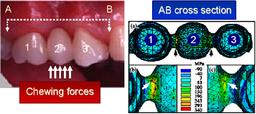|
|||||||||||
Cyclic Fatigue and Lifetime Prediction of Ceramics
Contact: André Studart
The fracture strength of ceramic materials is known to be inversely proportional to the largest or critical flaw (a) present in the microstructure, as described by Griffith's law.
Based on this general law, one could in principle be able to design structural ceramic components (of given flaw size a) in such a way that the stresses applied during use would be always inferior to the material´s fracture strength. Nevertheless, a particular and quite often risky feature of ceramic materials is that their microstructural flaws can grow over time even when the stresses applied to the component are below the component fracture strength (Fig. 1). This occurs due to a stress-induced corrosion mechanism that takes place at the crack tip, where water molecules interact with the ceramic material facilitating the breakage of the metal-oxide ionic-covalent bonds, as schematically represented in Fig. 1 for the case of silica. As a result of this crack growth phenomenon, the material fracture strength is gradually reduced over time until it achieves the stress level applied in the given loading conditions, leading to an abrupt failure of the ceramic part (Fig. 2). This illustrates the importance of understanding the subcritical crack growth behavior of ceramic materials if one aims to estimate the lifetime of structural and load-bearing ceramic components.
In our group, major efforts have been placed on the prediction of the lifetime of ceramic materials used in dental applications, namely crowns and bridges. Such ceramic-based protheses normally display a multi-layered structure that is submitted to cyclic chewing loads in the water-rich environment of the mouth, as illustrated in Fig. 3 for a three-unit ceramic bridge. Due to these particularities, a specific method for measuring subcritical crack growth has been chosen, which enables the determination of the lifetime of layered materials in different environments under similar cyclic conditions to those encountered in the mouth (see Fig. 4 and film below). Such method has the additional advantage of not requiring pre-cracking of the sample, which is expected to better mimic real dental protheses. A wide range of ceramic materials used in dental applications has been evaluated with the equipment shown in Fig. 4. The use of the fatigue machine is however not limited to dental protheses, but can also be extended for the lifetime prediction of diverse other ceramic and metal materials submitted to cyclic loads.
Film: Cyclic fatigue machine used for lifetime prediction of structural ceramics (wmv format or mpeg format or avi format).
Wichtiger Hinweis:
Diese Website wird in älteren Versionen von Netscape ohne
graphische Elemente dargestellt. Die Funktionalität der
Website ist aber trotzdem gewährleistet. Wenn Sie diese
Website regelmässig benutzen, empfehlen wir Ihnen, auf
Ihrem Computer einen aktuellen Browser zu installieren. Weitere
Informationen finden Sie auf
folgender
Seite.
Important Note:
The content in this site is accessible to any browser or
Internet device, however, some graphics will display correctly
only in the newer versions of Netscape. To get the most out of
our site we suggest you upgrade to a newer browser.
More
information





